Stefano Rossignoli – giugno 2014
In collaborazione con RADAR, il trimestrale del CAI di Corsico
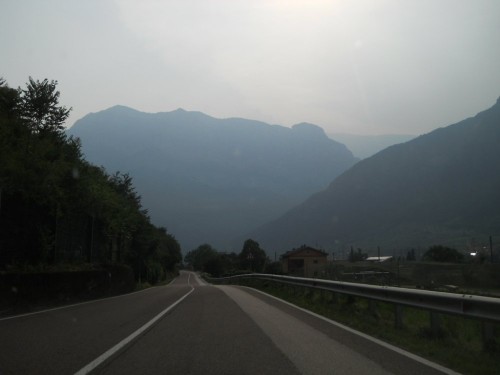
Una strada che attraversa le Alpi?
No, nooo! Ce ne sono già abbastanza mi sembra!!!
Intendo proprio la strada, il percorso che hanno fatto le le Alpi, le Prealpi, gli Appennini, ma anche l’Himalaya, le Ande e via dicendo, per arrivare lì dove si trovano ora…e soprattutto la strada che ha fatto la scienza per arrivare a capire la storia del nostro pianeta, ovviamente in sintesi e in modo non totalmente esauriente…
Non è mia la frase:”Tutto ciò che osserviamo è frutto di cambiamenti che avvengono ogni istante”.
Fu il grande Geologo, James Hutton, nei primi dell’ottocento ad andare contro tendenza rispetto alle idee passate, affermando e dimostrando che la Terra era in continuo cambiamento e in continua evoluzione.
Affermò anche che quel che possiamo osservare oggi in natura, è riconducibile ai fenomeni naturali del passato.
Questo, conosciuto come “Principio dell’Attualismo”, è ancora oggi una pietra miliare nelle Scienze Geologiche, Paleontologiche, ecc. In sintesi, bisogna conoscere e studiare i processi e gli eventi di oggi per comprendere al meglio quelli del passato…
Posso cercare di utilizzarlo per spiegare il titolo di questo articolo…
Parto dal presupposto che ormai tutti siano al corrente del fatto che la crosta terrestre si muove in continuazione.
Anche in terza elementare si studia la Pangea e i ragazzi imparano a capire che la Terra è cambiata e cambia in continuazione.
Ma come facciamo a saperlo? Ci sono modi per dimostrare che i continenti, i fondali oceanici e ogni cosa sul nostro pianeta si muove?
Ebbene sì! E sono molteplici…
Prima di tutto si possono fare misure dirette. Ad esempio a volte una placca o una massa rocciosa striscia sull’altra lungo fratture chiamate FAGLIE. Famosissima è quella di Sant’Andrea in California lungo la quale si può misurare lo spostamento di circa mezzo cm all’anno.
Senza andare troppo lontano, basterebbe mettere un misuratore di distanze al laser sullo stretto di Messina per notare un allontanamento tra Sicilia e Calabria di qualche mm per anno…
Le montagne franano e crollano in continuazione e quel che stava lassù, pian piano arriva sempre più in basso e cambia forma.
Si formano nuovi vulcani, quindi nuove montagne.
Alcune catene montuose stanno ancora crescendo come le nostre Alpi. Pochi anni fa, sul Monte Generoso conobbi un geologo che stava installando una sessantina di punti di riferimento per misurare accuratamente in movimento e l’eventuale innalzamento delle Alpi Svizzere…
Tornando in dietro nel tempo al 1835, il famoso naturalista Charles Darwin, assistette ad un disastroso terremoto nella città costiera di Concepcion in Cile, seguito da uno Tzunami. In realtà Darwin fu fortunato perché al momento del terremoto si trovava a circa 300km di distanza e, una volta giunto a Concepcion, potè studiarne le conseguenze e ascoltare i racconti dei superstiti…
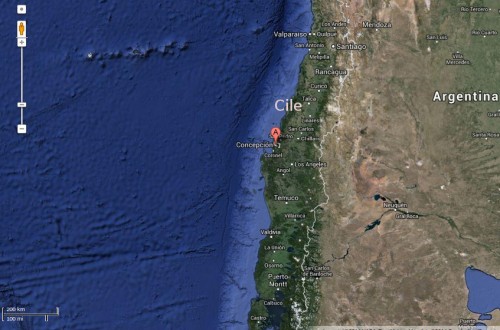
Tra le tante cose, il capitano Fitz-Roy del Brigantino “Beagle” su cui viaggiava Darwin, notò che al largo di Concepcion il fondale si era sollevato per circa tre metri al di fuori dall’acqua. Notò il sollevamento perché i sedimenti emersi erano pieni di molluschi in decomposizione che di solito vivono nei sedimenti del fondale marino.
Darwin aveva notato conchiglie di molluschi simili (fossilizzate) fino a 400m di quota e scrisse:”E’ arduamente possibile dubitare che la grande elevazione sia stata dovuta a piccoli sollevamenti successivi” dando così idea di come potevano essersi formate le Ande. Applicò il principio dell’Attualismo di J.Hutton seguito anche dall’amico geologo Charls Lyell.
Vedi link del racconto di Darwin (in inglese):
http://www.geo.cornell.edu/geology/faculty/RWA/research/current_research/chile-m-88-earthquake-page/darwins-description-of-the-.html
Il famoso naturalista però non conosceva l’origine dei terremoti, non sapeva che i terremoti erano solo la conseguenza di tali sollevamenti e quale fosse la forza che poteva averli prodotti.
Oggi però esistono misurazioni più moderne, magari indirette per cui si conosce anche l’origine dei continui movimenti e sollevamenti (o abbassamenti) della crosta terrestre, dell’innalzamento delle Ande e non solo!
Primo: nel centro degli oceani esiste sempre una grande catena montuosa detta “Dorsale Oceanica” composta interamente da spaccature di origine vulcanica che eruttano in continuazione producendo nuove rocce che comporranno nuovi lembi di crosta terrestre (chiamata crosta oceanica).
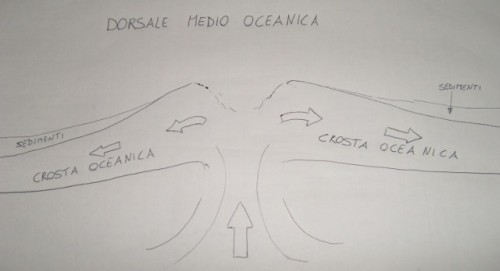
La crosta oceanica quindi si forma in continuazione, si sposta allontanandosi dalle dorsali con la velocità di qualche cm all’anno ed è in grado di spingere e spostare interi continenti per migliaia di km, a volte li spinge anche uno addosso all’altro!
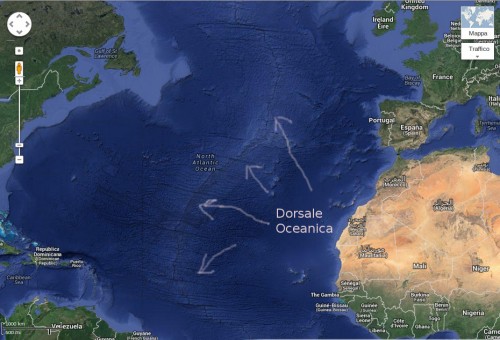
A volte, la crosta oceanica si infila “semplicemente” sotto la crosta continentale (questo è il caso dell’Oceano Pacifico e delle Ande e il fenomeno è chiamato “subduzione”). Qui, la crosta, a grande profondità si rifonde tornando magma il quale erutta o comunque si infila tra le spaccature della crosta e accresce la catena montuosa.
La scoperta della crosta oceanica che si infila sotto quella continentale è indiretta ed è dovuta alla misurazione dell’epicentro dei terremoti molto frequenti al margine tra Oceano Pacifico e America del sud (ma anche in altre zone della Terra!). Gli epicentri (ma sarebbe meglio chiamarli ipocentri!) seguono un piano inclinato che va dal confine tra mare e continente fino a circa 700km di profondità.
Furono due sismologi, studiosi dei terremoti, a scoprire questa correlazione e il piano su cui si immerge la crosta oceanica prende il loro nome “Piano di Wadati-Beniof”.
Un margine come quello Andino, caratterizzato dallo scivolamento di crosta oceanica sotto crosta continentale viene chiamato “Margine Attivo” (figura da Wikipedia).
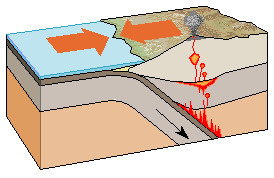
Quando la crosta oceanica invece si appoggia semplicemente al continente spingendolo, parliamo di “Margine Passivo” (e questo ad esempio è il caso dell’Africa che viene spinta dalla crosta dell’Oceano Atlantico).
Muovendosi in continuazione quindi le placche possono percorre migliaia di km.
Basta fare un breve calcolo e si scopre che in un milione di anni, con uno spostamento di un solo centimetro all’anno si percorrono ben 10km.
Nel caso delle Alpi, fu proprio l’apertura dell’Oceano Atlantico meridionale avvenuta circa 100 milioni di anni fa a spingere la placca Africana contro quella Europea. Si chiuse così un oceano pre-esistente il cui fondale andò in subduzione.
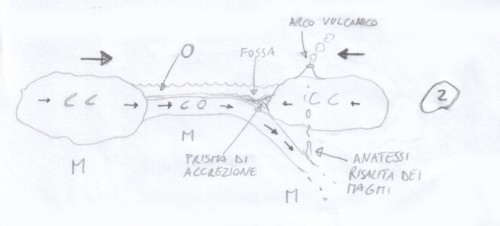
Durante la subduzione le rocce fusero (fenomeno detto Anatessi) e i magmi si infilarono nella crosta, alcuni eruttarono e altri si fermarono all’interno solidificando lentamente…
I sedimenti marini dei fondali furono spatolati, pressati, piegati e ammucchiati in quello che viene chiamato “prisma di accrezione”.

Poi fu la volta del “piccolo” promontorio Africano (chiamato Adria) che andò in collisione con il sud dell’Europa schiacciando , deformando e sollevando “definitivamente” il tutto…
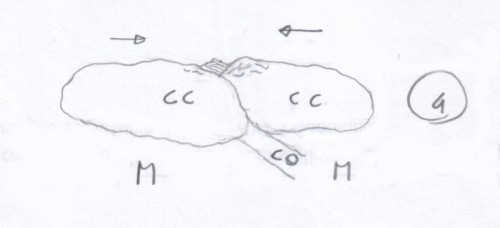
“Definitivamente” però è una parola che sulla Terra non si può utilizzare.
Le Alpi crescono ancora ma prima o poi tutto verrà eroso e tornerà una pianura…ma non credo che la vedremo!!!